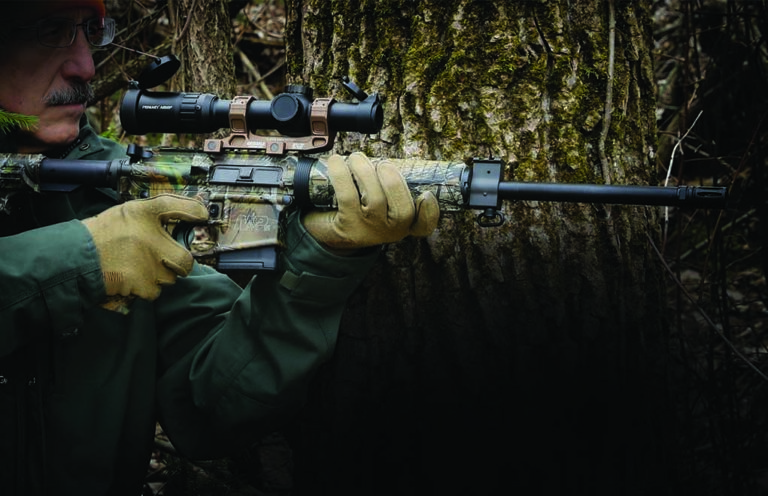
A lightweight carbine, and one with soft recoil, the S&W M&P15 in .300 Blackout is a stellar tool.
What You Get With The M&P15 In .300 Blackout:
- Bolt and carrier are mil-spec and are given a matte-black finish.
- Medium-profile barrel is made of 4140 steel, and the barrel is given an Armornite finish.
- Low-profile gas block has a section of Picatinny rail machined on top, also holds the front of the handguard.
- Boasts mil-spec trigger parts, with a pull weight on the order of 5 pounds.
- The carbine buffer tube has a mil-spec-shaped M4 carbine stock with six positions for length.
- Stock and the gas block each have a sling swivel.
- At 100 yards, capable of near MOA accuracy with the right load.
When I was learning guns and gunsmithing, Smith & Wesson was the handgun provider to law enforcement. Oh, it offered long guns from time to time, but not ones it actually made. The 21st century has brought us a lot of changes. S&W now makes revolvers, pistols and rifles. No shotguns, but this company would be crazy to try that … and S&W is not crazy.
Also, the .300 Blackout and its predecessor, the .300 Whisper, were once thought of as solely super-quiet, used-with-suppressors thumpers. Hurling 200-plus-grain bullets just under the speed of sound, they were essentially .45 ACP+P carbines that could be made the epitome of quiet.
Well, that also changed.
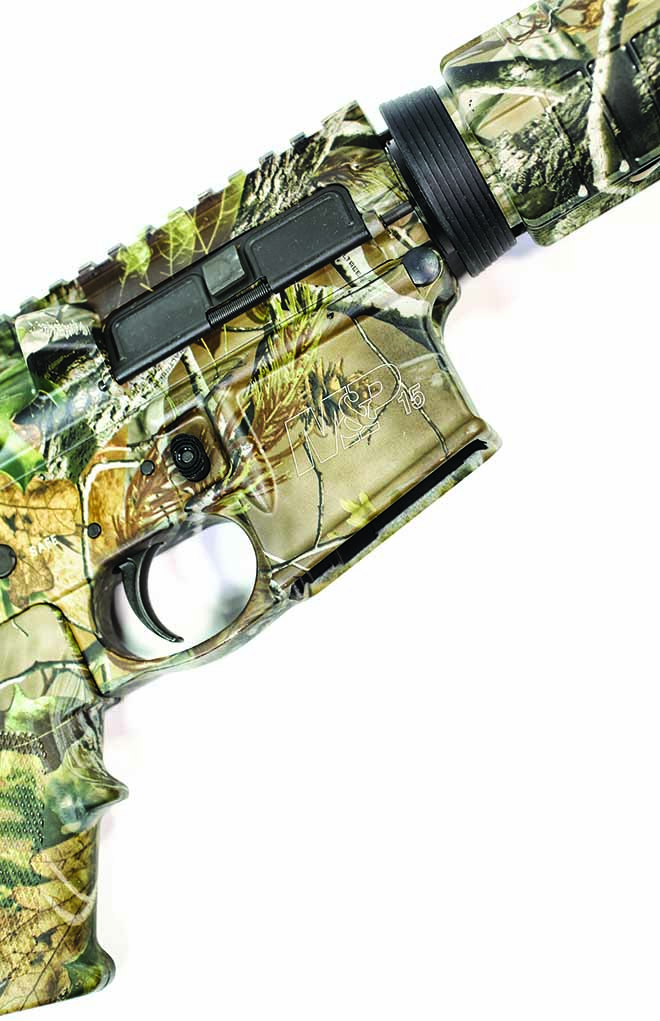
You see, the .300 BLK has just the right-sized case to get a 110- to 125-grain hunting-type bullet up to useful velocities. In fact, if you’re willing to go with a carbine or longer barrel, you can get those bullets up to pretty much equal the .30-30.
Handy Hunting Carbine
And S&W has the carbine for it, if not the rifle—the M&P15. Carbines are handier for hunting anyway. S&W starts with its excellent M&P receiver set—a pair of forgings that are machined to mil-spec dimensions. The flat-top receiver is ready for whatever optic or irons you select.
I see this as a good thing, because we all have different ideas as to what comprises the perfect setup for our own hunting situations. When gunsmithing, I had no end of customers who wanted a 3-9X scope on their .30-06 rifle for deer hunting. But where I hunted (and most of the state was the same, truth be told), 100 yards was a long shot, and 9X was more than I needed or wanted. So, “long” shots are most often at 100 yards, max, for most shooters and in most thick-cover situations.
However, S&W gives you the option of having more, if you want it. So, put the scope you want on top, using the rings you want, because S&W made that easy.
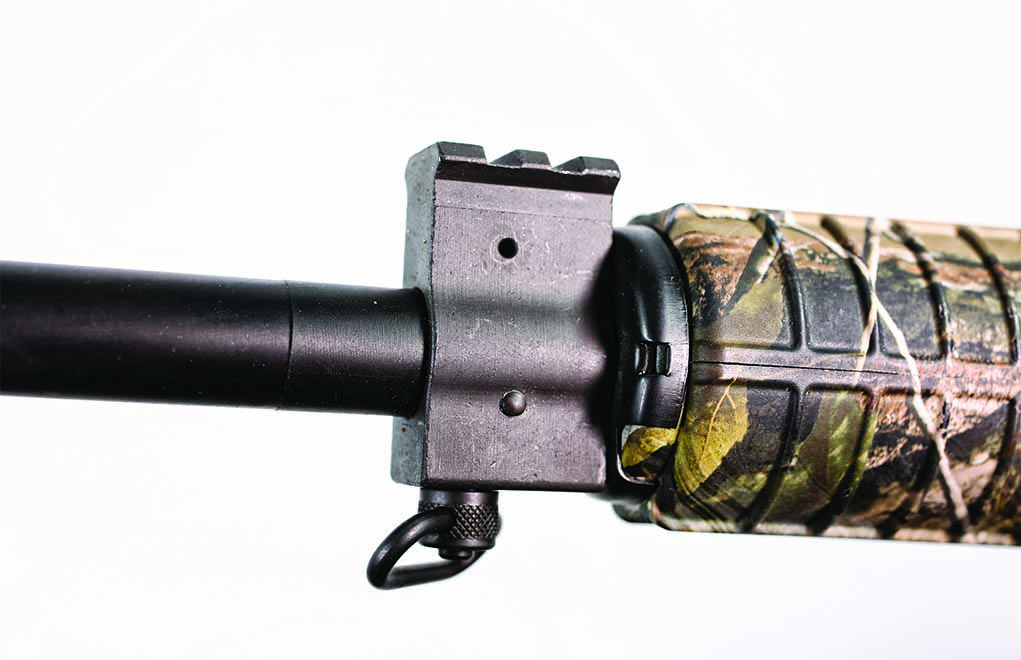
Inside, the the M&P15's bolt and carrier are mil-spec and are given a matte-black finish. They mate up with a medium-profile barrel that’s made of 4140 steel, and the barrel is given an Armornite finish. This is a surface-hardening and corrosion-resistance treatment that we’re now familiar with; it’s known as a “nitrocarburizing process.” The barrel has a twist of one turn in 7.5 inches—plenty fast enough to stabilize those heavyweights (should you wish to spend an afternoon of giggle-worthy plinking) while hurling 220- to 240-grain bullets downrange at leisurely velocities.
Get On Target With The AR:
- Go Small With These 8 Economical AR Pistol Options
- 8 Budget AR-15 Options: More Bang For The Buck
- AR-10 vs. AR-15: How Stoner’s Rifles Stack Up
- AR-15 Lower: Putting The Internals Together
- How It Works:The AR-15 Upper
Gas Block Details
The gas block isn’t a standard A1 triangle; rather, it’s a low-profile gas block with a section of Picatinny rail machined on top. This means that if you want iron sights on your S&W M&P15, you can do it. Just be sure to order a front sight that’s labeled as “gas block rail” height, not handguard height.
The gas block is also the part that holds the front handguard retaining ring in place. The M&P has standard carbine handguards—not a tacti-cool, free-float handguard. Some might see this as a step back. I don’t.
Free-float handguards are both an individual preference (in that regard, not unlike sights/optics) and more expensive than standard handguards. And, as with the optics, if you have a preference, and it matters that much to you, it’s easy enough to rebuild any AR-15 rifle or carbine.
M&P15: Trigger and More
The lower internals in the M&P15 are vanilla-plain, mil-spec trigger parts, which means it’s a single-stage trigger with a promise of something on the order of 5 pounds of pull weight. I know—we’re all accustomed to a clean, crisp, 3½-pound trigger, but that’s not always an option on an AR-15. And, when it is, it’s an expensive one. This one has a 4½-pound trigger with a short takeup and a relatively clean let-off. As mil-spec trigger parts sets go, this one’s pretty darned good.
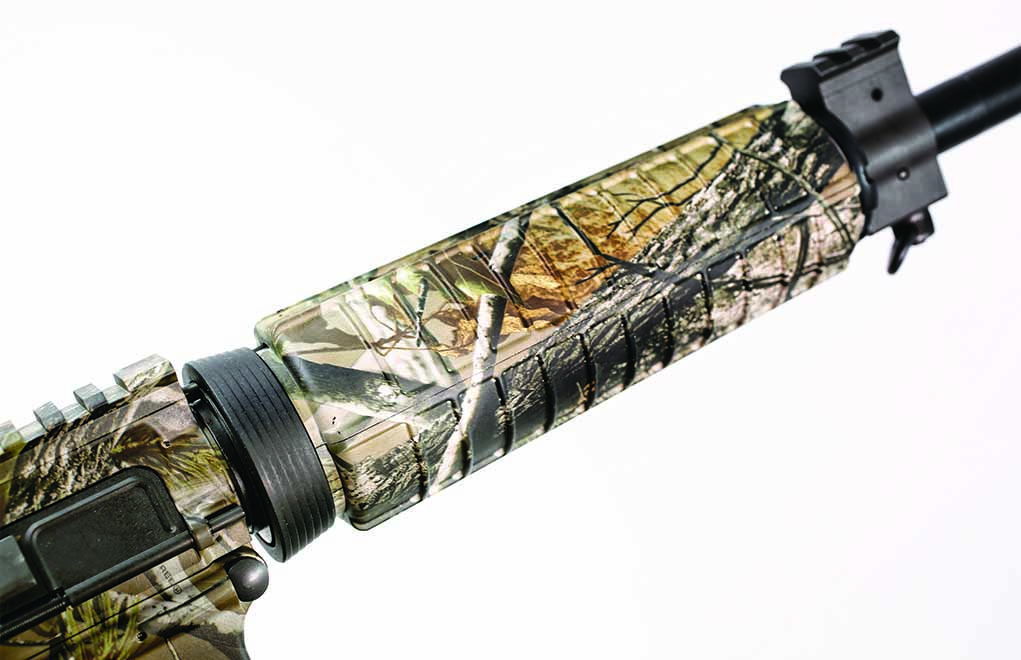
If you’re still worried that the trigger isn’t “good enough,” fear not. I have, on regular occasions, dropped the small, computer-controlled popup targets on a National Guard range—the 300-meter ones—with a rack-grade trigger on an M4 and iron sights. If you have magnifying optics or a red-dot sight and a deer at 100 yards, a 5-pound trigger isn’t going to be a hindrance.
The pistol grip is a standard A2 with the finger hook on the front face. However, the M&P15's trigger guard is integral to the lower receiver. Even so, it does have a bit of extra room—more than enough for a gloved trigger finger. And, if you’re wearing gloves, the 5 pounds of trigger weight are now a good thing.
On the back end, the carbine buffer tube has a mil-spec-shaped M4 carbine stock with six positions for length of pull adjustment. And again, if you’re sighting-in on a nice summer day in shirtsleeves, you’ll find that the length of pull you’ll need while in a blind, all bundled up on a November morning, will differ from the length of pull you need on a pleasant summer’s day. So, you can easily make it shorter to account for the extra insulation. This is one area in which the AR-15, as the modern sporting rifle, has it all over the traditional rifles and carbines.

The stock and the gas block each have a sling swivel, so you can easily install a sling for the hike to your blind. In addition—and not that you need it for most uses—the barrel is threaded at the muzzle, and S&W has installed a flash hider. I don’t know of any load for the .300 Blackout that produces enough muzzle blast to need a flash hider, but the company put one there because, well, some of you are going to install a suppressor, and for that, you need threads.
Blackout-Specific Bullets
As previously mentioned, the .300 Blackout was developed to be a heavy-thumper subsonic cartridge. Nevertheless, to use it for hunting calls for a lighter bullet, and that’s where the 110- to 125-grain bullets come in—unlike bullets designed for other cartridges (the .30 Carbine and the 7.62 AK come to mind), for which a stubby projectile is needed or demanded.
Just to fit the action, the Blackout has different needs. In order to feed properly, bullets have to be longer than the Carbine or AK bullets would be, and this means a bullet meant for the AK round won’t be suitable for loading in the Blackout. As a result, the cartridge-and bullet-makers came up with Blackout-specific projectiles.
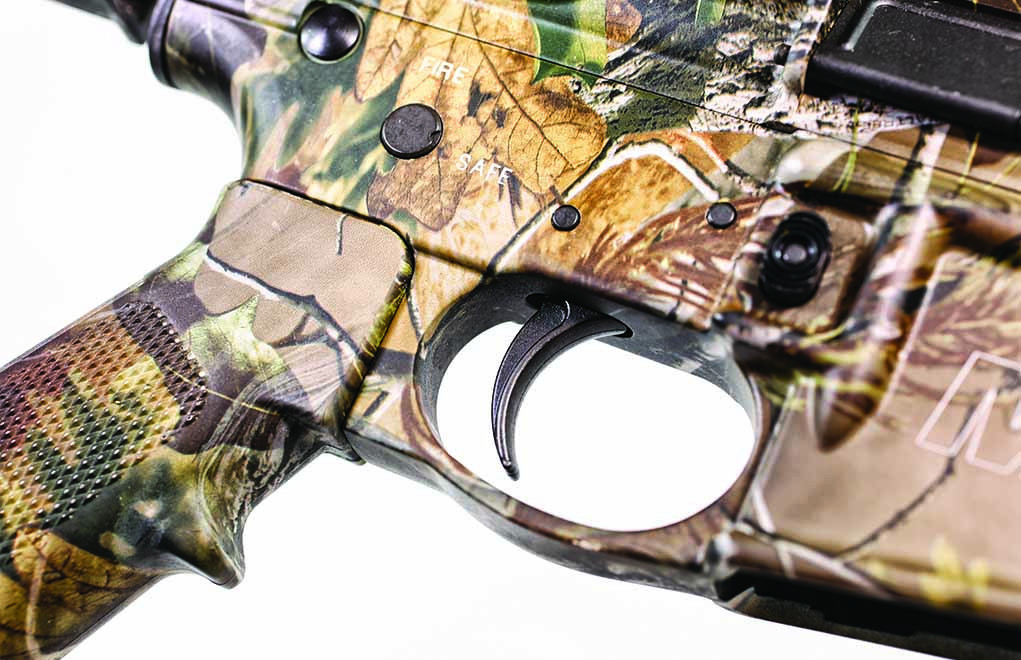
Another reason for the longer bullets, besides reliable feeding, is safety. It’s possible to mix up a .300 Blackout cartridge with .223/5.56 ammunition and not notice it while loading it into a magazine. A properly longer bullet in the .300 will wedge into the .223 chamber neck and prevent the bolt from closing (this situation is called a “clue”!). If that happens, you simply work the bolt to extract the improper cartridge, check the rest and continue.
A too-short bullet, in this instance, might allow the bolt to close. But, when you pull the trigger, bad things happen. Very bad things. So, don’t mix ammo; and, if the bolt won’t close, find out why. And don’t use a .300 cartridge loaded with a too-short bullet.
M&P15 Test Results
Testing the M&P15 was easy. I simply swept a suitable array of hunting loads off the shelf, carted the carbine to the range (along with a suitable scope) and had fun.
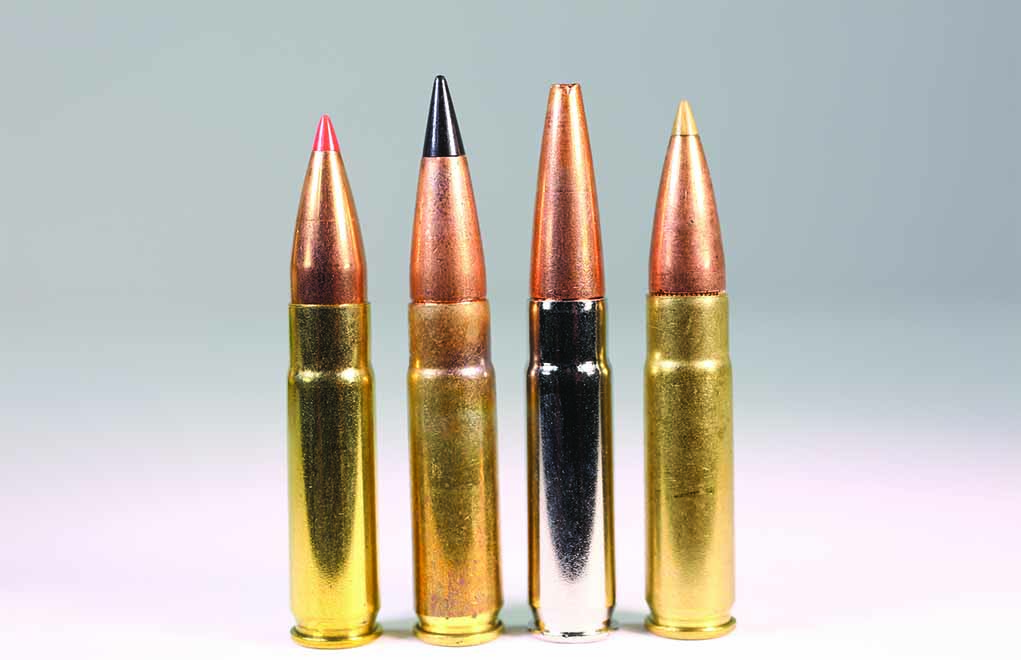
The scope I selected is a new one to me. It’s Primary Arms’ 1-6X24 ACSS-Raptor, which features a 30mm tube and an illuminated reticle. It’s a first focal plane optic, which means that the reticle apparently increases in size as you zoom up to 6X. For fast engagements, it has a reticle with a horseshoe loop, along with a chevron in the center with holdover bars for bullet drop compensation. Primary Arms is asking $400 for this scope—a smoking-good deal! It might sound like overkill, but I chose a Geissele Super Precision mount.
Considering the trajectory and range of the .300 Blackout, you simply (once zeroed) nestle the horseshoe behind the shoulder of the whitetail in question and cleanly press the trigger. As far as trajectory goes, if you sight-in dead on at 100 yards, your drop at 200 is going to be 5 inches. If you sight-in 1 inch high at 100 yards, you’ll be 3 inches low at 200. If you limit yourself to shots out to 180 yards, your bullet is never more than 1½ inches from your line of sight between 20 and 180 yards. Basically, you just point and click.
Those with sharp eyes can opt for a red-dot sight and use the 1X with the variable-power dot to aim with. Just for plinking fun, I parked an Aimpoint Micro m2 on top and had a merry time clanging the steel plates on my club’s 100-yard range.
Simply Stellar M&P15
Accuracy from the M&P15 and the various .300 loads was everything you’d need, and expect, for a hunting rifle. A lightweight carbine, and one with soft recoil, the S&W M&P15 is a stellar tool.

OK, here’s a comparison—the classic Winchester M94 carbine in .30-30. Here, we have an iron-sighted carbine with no provision to mount a scope. At 6.8 pounds, it fires a .308-inch bullet weighing between 125 and 170 grains. The current standard is 150 grains. The “book” velocity on a 125-grain bullet is approximately 2,500 fps, but you can chronograph a lot of .30-30 ammunition and never see that. Mostly, your 125-grain bullet will be doing (big surprise) 2,400 fps or slightly fewer. Oh, and your .30-30 is always going to be a five-shot lever gun. But, the M&P15 can easily be fed from a five-shot magazine or can use 30-rounders for plinking.
The M&P15 in .300 Blackout gets a 125-grain bullet up to more than 2,300 fps. Sure, that isn’t the more-than-2,400 fps the .30-30 can allegedly do, but with the M&P15, you get a self-loading rifle of the same weight with easy optics mounting options and velocity that’s more than close enough. And really, I’m not sure the difference matters to any whitetail out there.
The bonus Mossy Oak camo pattern is something that comes with the M&P and saves you the work of trying to camo-paint your own flat-black MSR.
If you have a .30-30 and want to hunt with the same rifle your father, grandfather and perhaps even your great-grandfather used, don’t let me stop you. However, the S&W M&P15 Mossy Oak camo in .300 Blackout could be the start of a new tradition.
M&P15 in .300 Blackout Specs
Type: Gas-operated, self-loading rifle
Caliber: .300 Blackout
Capacity: 30+1 rounds
Barrel: 16 in.
Length: 35 in.
Weight: 6 lb., 9 oz.
Trigger: 4.5 lb.
Finish: Anodized aluminum, black oxide steel
MSRP: $ 1,119
For more information on the M&P15, please visit smith-wesson.com.
Editor's Note: This article originally appeared in the June 2020 issue of Gun Digest the Magazine.

Next Step: Get your FREE Printable Target Pack
Enhance your shooting precision with our 62 MOA Targets, perfect for rifles and handguns. Crafted in collaboration with Storm Tactical for accuracy and versatility.
Subscribe to the Gun Digest email newsletter and get your downloadable target pack sent straight to your inbox. Stay updated with the latest firearms info in the industry.

![Best Concealed Carry Guns In 2025 [Field Tested] Wilson Combat EDC X9S 1](https://gundigest.com/wp-content/uploads/Wilson-Combat-EDC-X9S-1-324x160.jpg)


![Best 9mm Carbine: Affordable PCCs [Tested] Ruger Carbine Shooting](https://gundigest.com/wp-content/uploads/Ruger-Carbine-Shooting-100x70.jpg)
![Best AR-15: Top Options Available Today [Field Tested] Harrington and Richardson PSA XM177E2 feature](https://gundigest.com/wp-content/uploads/Harrington-and-Richardson-PSA-XM177E2-feature-100x70.jpg)

Who TF wrote this garbage, AI?